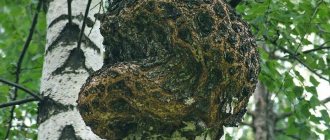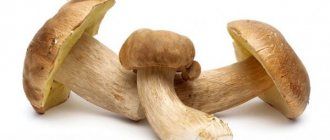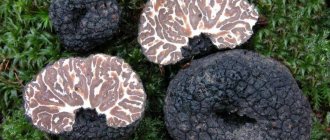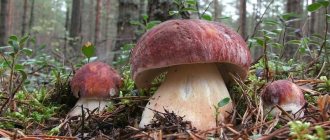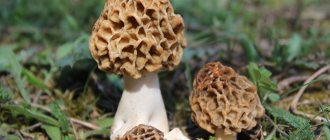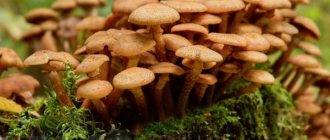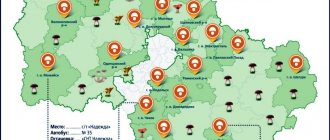Growing mushrooms in a greenhouse is a very interesting topic, which we have already talked about. But we came up with the idea of growing oyster mushrooms at the dacha. To what extent this is possible and what is necessary for growing oyster mushrooms in the country, we will consider now.
Oyster mushrooms are an excellent and fast-growing type of mushroom, which for many has become not only a product of their own production, but also an industrial crop that has firmly occupied a certain niche in the market. By and large, such mushrooms are inexpensive, and you won’t earn much by growing them in your dacha in small quantities, but you can always organize a small “bed” in a certain room and get fresh mushrooms every day for your own needs. Boiled, fried, stewed, pickled, canned oyster mushrooms, mushrooms in a salad or fried - all this will no longer be a problem if you start growing it in the country. Of course, there is the organization of a place for production and some start-up expenses ahead, but then - no problems, and only fresh and aromatic mushrooms every day.
How long does it take for mushrooms to grow? Types of oyster mushrooms and what mushrooms grow in the forest on the ground
There are five species of this mushroom found in the wild, and all of them are considered conditionally edible. Therefore, a piece of advice for cooks: oyster mushrooms should be pre-boiled in salted water for 20 minutes. These mushrooms are found in all countries of the former Soviet Union.
The most common is the oyster mushroom, or oyster mushroom.
There are abundant, pulmonary, late and steppe oyster mushrooms. By the way, there is only one type of oyster mushroom that grows in the forest “on the ground” - this is the steppe one. However, even here the surface of the earth in the clearings should be densely strewn with bark and branches of broken trees. Therefore, it seems as if the mushrooms are growing directly on the ground.
Although the types of oyster mushrooms differ in color, size and shape of the caps, they all grow in large colonies on the trunks of dead trees - standing or fallen.
Look at the photo of how oyster mushrooms grow in the forest. They hang from the trunks in a large stepped garland, the weight of which can reach more than 3 kg. If mushrooms grow on a fallen tree, their stems are long and located close to the side of the cap. And if their colony has formed on a still standing tree, their legs are short, as if fused together.
The harvest time for oyster mushrooms ranges from April to November frosts. However, even frost is not harmful to these mushrooms: they do not lose their taste and nutritional properties. In addition, this type of fruiting bodies is not damaged by worms while they are young. Only on very old copies can deterioration be noticed.
Another type of oyster mushroom is the abundant one, which grows in deciduous forests. Its collection begins in May and lasts until October. These mushrooms are afraid of frost, so you shouldn’t look for them in cold weather. The most abundant fruiting of oyster mushrooms occurs in June and then in October. They love humidity, and at this time of year, especially during rainy weather, there are a lot of fruiting bodies in the forest. They can often be found on old birch, elm, rowan and oak trees. The abundant oyster mushroom has a wavy edge of the caps and a light cream color. The stem of the mushroom is long and curved towards the cap.
Another type of oyster mushroom is pulmonary, which is distinguished by its white color. It has a convex cap with thin edges drooping downwards. Her leg is covered with delicate white fluff, reminiscent of velvet. Grows in colonies on oaks, birches and beeches. Although the pulmonary oyster mushroom looks very tender and delicate, it is easily transported and tolerates cold well for 4 days. This type of mushroom can easily take root at home: place wild oyster mushrooms in the yard near the stumps, and after a while you will see the result - a good harvest of home-grown mushrooms.
Blocks after three harvests
You will harvest your first harvest in a month. After three harvests, you can break the block into small segments and use it as mulch or cover it with fresh boiled straw to get an oyster mushroom harvest again in a month.
If you cut off the bottom of the stems from mushrooms from one harvest, this amount of material will be enough for a new block. One of my blocks holds 3 forty-liter cans of steamed straw, and the second block holds two cans. After three harvest waves, each of them will become two to two and a half times lighter, because moisture and nutrients will leave the straw.
* * *
In India, people grow oyster mushrooms in landfills using old jeans as a base, but textile dye is as harmful to humans as newspaper dye. To grow healthy and tasty mushrooms, it is not at all difficult to collect leaves from under trees, find hay, straw or sawdust. You can mow weeds or grass outside the site, chop them up and steam them - this will be an ideal substrate for oyster mushrooms.
I’ll tell you about growing oyster mushrooms in jars next time.
How long does it take for mushrooms to grow after cutting? Features of growth and development of mushrooms
Most mushrooms grow within two weeks. In this short period of time, the mushroom manages to reach standard sizes, but often growth stops already on the fifth day. Interestingly, the diameter of the fruiting body continues to increase even after upward growth has stopped. Looking at the mushroom, you can decide that its cap takes the longest to grow, and this is true.
Its development most actively occurs after the end of the growth period of the leg; the diameter increases due to growth along the periphery. This is due to the fact that the stem itself is the connecting component between the cap and the main mass of the mycelium. But at the same time, the stalk itself is a structural component of the mycelium. The thinnest strands of micelles rise above the surface, merge and form something similar to a fruiting body.
And after a week we can see a classic mushroom, which, after a detailed examination, must be sent to the basket.
A careful inspection is a strictly necessary measure, because even edible mushrooms can cause poisoning. Poisonous mushrooms are dangerous due to toxins, but edible ones can grow next to busy sections of highways, collecting all the elements of the periodic table. And measures to trim the fruiting body will not help, because heavy metals settle in the soil.
It is from this soil that the mycelium micelle receives nutrients, develops and gives rise to new fruiting bodies. So don’t be lazy to go some distance from any highways, to the permanent paths of mushroom pickers.
Another feature of mushrooms is that they are practically not processed in our intestines, like fiber. Thanks to this, mushrooms are able to improve motility and normalize the functioning of the gastrointestinal tract.
Material for propagation of oyster mushrooms
I am often asked where to get mushrooms or mycelium for propagation. Oyster mushrooms grow in almost every region, and you can collect them. They come in different colors: summer and autumn, white, grey, black and pink. They taste a little different too. So look for the ones you like best.
You need to buy mycelium, but when you order it, choose the same variety to your taste. Mycelium will produce mushrooms a little later than mushroom pieces, but the yield will be about the same. Therefore, it is not necessary to buy mycelium; you can propagate oyster mushrooms with pieces of mushrooms, especially since now, in the fall, oyster mushrooms grow everywhere in countless quantities. You can pick mushrooms in spring and even in winter during a prolonged thaw.
They also asked me what mushrooms can be grown on sawdust. I answer: oyster mushrooms, shiitakes and honey mushrooms.
- Is it possible to grow bluelegs in your own garden and how can you transfer mycelium from a clearing?
How long do mushrooms grow after rain? Diary of a mushroom picker. Mushroom growth rate.
They grow like mushrooms after rain...
But really, how fast do mushrooms grow?
Record holder for speed of growth of Veselka -
Boletuses, boletuses and white boletuses do not grow so quickly, but already on the 2-3rd day they are of interest to the mushroom picker.
Day 1. Photo by Olga Gubanova
Day 2 photo by Olga Gubanova
Day 4 Photo by Olga Gubanova
In general, the fruiting body of a sponge mushroom grows in 5 days, then ripening and release of spores begins, but this process only frustrates mushroom pickers.
If a ripe white one can still be considered a trophy (many even prefer them to young ones for their richer taste), then boletus mushrooms older than 2 days are usually no longer of interest to the mushroom picker.
Lamellar mushrooms grow slower than tubular mushrooms, especially chanterelles. Chanterelles generally “freeze” under unfavorable conditions, such as drought, then begin to grow again. Many mushroom pickers noticed that the embryos of chanterelles (primordia) disappeared altogether, never starting to grow, as would be drawn back into the mycelium.
Of the lamellar ones, the fastest one is russula, which rises quite quickly from the litter above the ground and opens within 2-3 days.
Valui is also a russula. photo Flint
a day later - they opened up noticeably. photo Flint
Polypores grow slowly, especially on living trees. In general, the growth process depends on many factors - temperature, humidity, the strength of the mycelium itself, etc.
The main thing is that they grow! And we will find them in any case!
A piece
Well done to those who finished reading!
Subscribe if you love forests and mushrooms!
Errors during cultivation
Oyster mushrooms rarely get sick and generally create fewer problems than other mushrooms. If something goes wrong, most often we ourselves or poor-quality mycelium are to blame. Let's look at the most common mistakes when growing oyster mushrooms:
- Poor germination of the mycelium and the appearance of green or dark spots on the surface of the block are caused by poor quality of the mycelium or non-compliance with hygiene standards during inoculation. Oyster mushrooms will appear later, there will be fewer of them, but the quality will not suffer.
- Weak and late overgrowth of mycelium - errors in preparing the block for growing mushrooms, overheating, hypothermia or other violations of the content of oyster mushrooms. Correct the problems.
- Unpleasant odor and color of the contents of the mushroom block - overheating or waterlogging. You may have forgotten to make drainage holes at the bottom of the bag with the mycelium-sown substrate for growing oyster mushrooms.
- Developmental delay – errors in temperature or water conditions, lack of ventilation.
- The appearance of midges is caused by storing vegetables in close proximity to mushroom blocks or failure to follow hygiene rules when growing oyster mushrooms. Disinfect the room and eliminate the source of insects.
- A decrease in yield is a violation of the rules for growing oyster mushrooms or low-quality mycelium.
Mushrooms may be unmarketable for the following reasons:
- a small hat on a long stem - lack of light;
- the cap of the oyster mushroom is funnel-shaped, the leg is bent - lack of fresh air or overripe mushrooms;
- a small cap on a thick stem - the substrate is too loose and wet;
- Oyster mushroom druse looks like coral - lack of oxygen.
How quickly Polish mushrooms grow. Polish mushroom: features of appearance and distribution area
Appearance This species, also known as chestnut mushroom or pan mushroom, is a representative of the trumpet mushrooms and belongs to the genus Mossaceae. During the Middle Ages, the main country supplying Polish mushrooms to European markets was Poland. This is what gave this type of mushroom such an unusual name. Description of the Polish mushroom It’s worth starting with the cap. It is dome-shaped and has a fairly large diameter. In adults, the cap can reach 12-15 cm. The surface of the cap of adult mushrooms is dry and smooth, while in young ones it is velvety. The color of the cap also varies depending on age: from light chestnut to brown. The tubular layer is white or yellowish-green in color. The leg is usually elongated - cylindrical in shape, growing up to 14 cm in height. The diameter of the leg ranges from 1 to 5 cm. And the color can be yellowish, brown or white-cream. Along the entire length of the leg there is a pattern in the form of stripes and relief, corresponding to the color of the cap. The pulp of the mushroom has a hard structure when young, but becomes softer with age. However, the overall structure of the “Mr. in the Hat” still remains meaty. The color is light yellow or white, but in the cut areas the color changes to blue. Where do Polish mushrooms grow and how to collect them?
Collecting Polish mushrooms is not so easy. The fact is that their habitat is very specific and selective. This species is most widespread in countries such as the Czech Republic, Hungary, Germany, Poland, as well as the Far East region. The Polish mushroom does not tolerate arid climates, and therefore lives in coniferous or mixed forests, preferring acidic soils.
Most often, you can find the Polish mushroom at the base of old trees (oak, pine, etc.) or in the moss litter. What makes it easier to find this beauty is that it usually settles in groups. The main period for collecting this type of mushroom is at the end of summer and beginning of autumn. Possessing a fairly high resistance to cold, it easily tolerates the first autumn frosts.
Doubles in the mushroom world
In the world of mushrooms, the Polish mushroom is quite easily confused with numerous representatives of the flywheel and white mushroom. Flywheels: motley, brown and green are the undisputed leaders in this aspect. Many inexperienced mushroom pickers believe that Polish is similar to white. There is some truth in this: young specimens of the Polish mushroom are indeed close in color, shape and size to white ones.
But there is a simple way to distinguish them: when cut, the Polish mushroom turns blue, which does not happen in the case of boletus mushroom. The “Polish gentleman” also has poisonous counterparts. Satanic and bilious are similar to it. They are distinguished from Polish by the peculiarity of the color of the cap, the tubular layer and the pattern on the stem. You can also check them by making an incision and observing the color change. Use in cooking Polish mushroom has a pleasant smell with notes of fruit. It tastes a little sweet. In culinary matters, it can be used in any form. This beauty does not lose its taste and nutritional qualities during processing, and therefore is suitable for frying, drying, pickling, and freezing for the winter.
Nutrient medium for oyster mushrooms
Blocks with pieces of mushrooms are not inferior in yield to blocks with mycelium. The yield depends not on what you infected the block with, but on the nutritional value of the medium in which you place the pieces of mushrooms or mycelium.
I grow mushrooms in barley straw, which is considered a less nutritious medium than, for example, sawdust or sunflower husks because it has a lower nitrogen content. In addition, it is long and much more difficult to compact in a bag than steamed sawdust.
- What mushrooms from the forest can be transferred to the garden and how to do it correctly?
Mushrooms can be grown on any cellulose, but in no case should you make a block from newspaper, because printing ink contains lead, which is toxic to humans. It is better to use straw, husks, sawdust, tree leaves and even toilet paper - anything that contains cellulose.
It is advisable to finely grind the filler. I didn’t chop the straw, and this had an impact later: the mushroom harvest is 15% of the weight of the filler, and the finer the filler, the more of it fits into the bag. That is, there is a direct dependence. But keep in mind that with each wave the yield is halved because the nutritional value of the environment decreases. Therefore, you can only get three crops from one block, and then you need to make a new block.
What remains in the bag after three harvests can be used as mulch or dug up with soil in any bed to loosen and fertilize the soil.
What time do boletus mushrooms grow? Cooking methods
Freshly picked mushrooms must first be cleared of debris and grass, the base at the stem must be cut off and the gray shell of the stem must be removed. Fill with cold water and rinse thoroughly. And then you can
— Boil
Pour water into a large saucepan and add salt per 1 kg. mushrooms 1 tbsp. salt. You can put the mushrooms in cold water, or in boiling water. The first water is usually drained and filled with clean cold water. Boletus mushrooms should boil for about 40-50 minutes. You will need to remove the foam from time to time. The finished mushrooms sink to the bottom of the pan.
- Fry
Usually, before frying boletus mushrooms, they are boiled for 20 minutes. Fry for about 30 minutes, uncovered. Or you can immediately put clean chopped mushrooms into the frying pan and cover with a lid. First they will stew, release the water, and then fry. Later you can add potatoes to them. Often all this is topped with sour cream.
— Salt
- 120 ml water;
- 40 g salt;
- 2 cloves;
- 4 bay leaves;
- 5 peppercorns;
- several sprigs of dill.
Peel the mushrooms, rinse, cook for 15 minutes, drain in a colander and place in jars, sprinkling them with salt. Prepare the brine separately: put cloves, dill, pepper and bay leaf into boiling water. Pour the brine over the mushrooms and put them in a dark, warm place. After a month, the mushrooms are ready.
— Marinate
For 1 kg. mushrooms you will need:
- 2 tbsp. l. salt;
- 2 tbsp. l. vinegar 9%;
- 2 tbsp. l. lemon juice or citric acid;
- 1/2 tsp. allspice peas;
- 5 bay leaves.
Peel, wash, cut the mushrooms, boil in plenty of water for 50 minutes (do not forget to remove the foam). Then add vinegar and seasonings to the water, cook the mushrooms for another ten minutes. Then remove the mushrooms from the pan with a slotted spoon and immediately place them in jars and pour the same broth on top. Roll up the jars, let them cool and put them in the cellar until winter.
— Dry
For drying, select boletus mushrooms without damage are selected. Clean, rinse well, place on a towel or napkin to drain. Then spread on baking paper and dry in the oven at a temperature of about +50 degrees with the door open. Mushrooms can be dried whole, large ones can be cut.
The boletus mushroom is one of the most common in Russia and neighboring countries. The aroma and taste allow it to be used for preparing delicious dishes and preparations. In some countries, this mushroom is not considered valuable for cooking, but in our latitudes it is one of the indispensable products included in national dishes.
Boletus mushrooms are not grown on an industrial scale - you can only get such a delicacy in the forest or birch grove, collecting the best specimens yourself. But, before you go mushroom hunting, you need to read the exact description of this mushroom and find out where and when it grows.
How to make blocks for oyster mushrooms
The question is often asked what blocks for oyster mushrooms can be made from. If you infect a wooden log with soft wood with mycelium, then oyster mushrooms will bear fruit on it for 3-4 years, and on hard wood you will receive a harvest annually for 7 years. It's raining now and the mushrooms in my garden are growing quickly. I also keep bagged blocks in the garden.
To create a nutrient medium in the bags, you need a filler - straw, sawdust, husks or other organic matter - add water and boil for 10 minutes. When the filler has cooled to room temperature, I put it into bags and hang it on a tree to drain off excess moisture. Organic matter should be moist, but water should not drip from it.
Then I place the substrate in a sugar bag, from which almost no moisture evaporates: the substrate must be damp all the time. Having added pieces of mushrooms or mycelium to the bag, I mix the contents, compact it tightly, tie the bag and secure the knot with tape or tape. Then I make three or four small cuts in the bag on different sides.

